A Robust and Efficient UAV Path Planning Approach for Tracking Agile Targets in Complex Environments
Abstract
1. Introduction
- A prediction method for tracking targets with free intention is proposed, which is based on a polynomial regression design and takes into account the surrounding environment of the target. The proposed method has at least 40% superior accuracy compared to the leading methods in the field.
- A secure tracking trajectory planning strategy is presented, which consists of a dynamic search front end considering dynamic constraints and a spatiotemporally optimal trajectory optimizer as a back-end.
- A fully functional UAV path planning approach forming a system-level solution for tracking targets was designed, which integrates the proposed method and perception functions.
2. Problem Description
2.1. Design Assumptions
- The sensing range of the omnidirectional distance sensor configured by the UAV system is limited. The existence of obstacles can be detected online through the sensors.
- The target motion conforms to the dynamic characteristics, the change of velocity and acceleration are continuous and have an upper limit. The target does not stop suddenly or reverse movement.
- The UAV can observe the pose of the target and noise online and estimate its state.
2.2. Architecture of UAV Path Planning Approach
3. Target Motion Estimation and Prediction
3.1. Target Path Prediction
3.2. Time Prediction
3.3. Target Relocate
4. Safe Tracking Trajectory Planning
4.1. Dynamic Tracking Path Searching
4.2. Spatial–Temporal Optimal Trajectory Generation
| Algorithm 1: Trajectory searching for dynamic tracking. |
| Input: openlist , closelist , current node , predicted trajectory , initial state , goal state . |
| Output: Target tracking trajectory . |
| 1:initialization () |
| 2:while is not empty do |
| 3: ← FindMinCostNode() |
| 4: ← GenerateGoal(, ) |
| 5: if Reach(, ) or AnalyticExpand(, ) Then |
| 6: return OptimalSearchPath() |
| 7: end if |
| 8: .push_back() |
| 9: ← Expand() |
| 10: for in do |
| 11: ← GenerateGoal(, ) |
| 12: if Nofeasible() or Then |
| 13: continue |
| 14: end if |
| 15: ←.g+EdgeCost ) |
| 16: ifThen |
| 17: .push_back() |
| 18: else ifThen |
| 19: continue |
| 20: end if |
| 21: ← |
| 22: ← |
| 23: ←+Heuristic() |
| 24: end for |
| 25: end while |
| 26: return Target tracking trajectory |
5. Numerical Case Study
5.1. Implementation Details
5.2. Experimental Results
5.3. Benchmark Comparisons
6. Conclusions and Future Work
Author Contributions
Funding
Institutional Review Board Statement
Informed Consent Statement
Data Availability Statement
Conflicts of Interest
Abbreviations
| UAV | unmanned aerial vehicle |
| QP | quadratic programming |
| ESDF | Euclidean signed distance field |
| OBVP | optimal boundary value problem |
References
- Shen, S.; Mulgaonkar, Y.; Michael, N.; Kumar, V. Vision-Based State Estimation and Trajectory Control Towards High-Speed Flight with a Quadrotor. Robot. Sci. Syst. 2013, 1. [Google Scholar] [CrossRef]
- Goodarzi, F.A.; Lee, D.; Lee, T. Geometric adaptive tracking control of a quadrotor unmanned aerial vehicle on SE (3) for agile maneuvers. J. Dyn. Syst. Meas. Control 2015, 137, 091007. [Google Scholar] [CrossRef]
- Mellinger, D.; Michael, N.; Kumar, V. Trajectory generation and control for precise aggressive maneuvers with quadrotors. Int. J. Robot. Res. 2012, 31, 664–674. [Google Scholar] [CrossRef]
- Ge, P.; Chen, Y.; Wang, G.; Weng, G. An active contour model driven by adaptive local pre-fitting energy function based on Jeffreys divergence for image segmentation. Expert Syst. Appl. 2022, 210, 118493. [Google Scholar] [CrossRef]
- Penin, B.; Giordano, P.R.; Chaumette, F. Vision-based reactive planning for aggressive target tracking while avoiding collisions and occlusions. IEEE Robot. Autom. Lett. 2018, 3, 3725–3732. [Google Scholar] [CrossRef]
- Ge, P.; Chen, Y.; Wang, G.; Weng, G. A hybrid active contour model based on pre-fitting energy and adaptive functions for fast image segmentation. Pattern Recognit. Lett. 2022, 158, 71–79. [Google Scholar] [CrossRef]
- Liu, S.; Watterson, M.; Mohta, K.; Sun, K.; Bhattacharya, S.; Taylor, C.J.; Kumar, V. Planning dynamically feasible trajectories for quadrotors using safe flight corridors in 3-d complex environments. IEEE Robot. Autom. Lett. 2017, 2, 1688–1695. [Google Scholar] [CrossRef]
- Chen, Y.; Cheng, C.; Zhang, Y.; Li, X.; Sun, L. A Neural Network-Based Navigation Approach for Autonomous Mobile Robot Systems. Appl. Sci. 2022, 12, 7796. [Google Scholar] [CrossRef]
- Bošnak, M.; Matko, D.; Blažič, S. Quadrocopter hovering using position-estimation information from inertial sensors and a high-delay video system. J. Intell. Robot. Syst. 2012, 67, 43–60. [Google Scholar] [CrossRef]
- Cheng, C.; Chen, Y. A Neural Network based Mobile Robot Navigation Approach using Reinforcement Learning Parameter Tuning Mechanism. In Proceedings of the 2021 China Automation Congress (CAC), Beijing, China, 22–24 October 2021; pp. 2600–2605. [Google Scholar]
- Teuliere, C.; March, E.; Eck, L. 3-D model-based tracking for UAV indoor localization. IEEE Trans. Cybern. 2014, 45, 869–879. [Google Scholar] [CrossRef] [PubMed]
- Martínez, C.; Mondragón, I.F.; Olivares-Méndez, M.A.; Campoy, P. On-board and ground visual pose estimation techniques for UAV control. J. Intell. Robot. Syst. 2011, 61, 301–320. [Google Scholar] [CrossRef]
- Gomez-Balderas, J.E.; Flores, G.; García Carrillo, L.R.; Lozano, R. Tracking a ground moving target with a quadrotor using switching control. J. Intell. Robot. Syst. 2013, 70, 65–78. [Google Scholar]
- Weiss, S.; Achtelik, M.W.; Lynen, S.; Achtelik, M.C.; Kneip, L.; Chli, M.; Siegwart, R. Monocular vision for long-term micro aerial vehicle state estimation: A compendium. J. Field Robot. 2013, 30, 803–831. [Google Scholar] [CrossRef]
- Dong, J.; Mukadam, M.; Dellaert, F.; Boots, B. Motion planning as probabilistic inference using gaussian processes and factor graphs. Robot. Sci. Syst. 2016, 12. [Google Scholar] [CrossRef]
- Kim, J.; Shim, D.H.; Morrison, J.R. Tablet PC-based visual target-following system for quadrotors. J. Intell. Robot. Syst. 2014, 74, 85–95. [Google Scholar] [CrossRef]
- Azrad, S.; Kendoul, F.; Nonami, K. Visual servoing of quadrotor micro-air vehicle using color-based tracking algorithm. J. Syst. Des. Dyn. 2010, 4, 255–268. [Google Scholar] [CrossRef]
- Liu, F.; Wei, Z.; Zhang, G. An off-board vision system for relative attitude measurement of aircraft. IEEE Trans. Ind. Electron. 2021, 69, 4225–4233. [Google Scholar] [CrossRef]
- Knuth, C.; Chou, G.; Ozay, N.; Berenson, D. Planning with learned dynamics: Probabilistic guarantees on safety and reachability via lipschitz constants. IEEE Robot. Autom. Lett. 2021, 6, 5129–5136. [Google Scholar] [CrossRef]
- Ohnishi, M.; Wang, L.; Notomista, G.; Egerstedt, M. Barrier-certified adaptive reinforcement learning with applications to brushbot navigation. IEEE Trans. Robot. 2019, 35, 1186–1205. [Google Scholar]
- Chen, Y.; Zhou, Y. Machine learning based decision making for time varying systems: Parameter estimation and performance optimization. Knowl.-Based Syst. 2020, 190, 105479. [Google Scholar] [CrossRef]
- Chen, H.; Liu, Z.; Alippi, C.; Huang, B.; Liu, D. Explainable Intelligent Fault Diagnosis for Nonlinear Dynamic Systems: From Unsupervised to Supervised Learning. IEEE Trans. Neural Netw. Learn. Syst. 2022. [Google Scholar] [CrossRef] [PubMed]
- Chen, Y.; Zhou, Y.; Zhang, Y. Machine learning-based model predictive control for collaborative production planning problem with unknown information. Electronics 2021, 10, 1818. [Google Scholar] [CrossRef]
- Chen, H.; Jiang, B.; Ding, S.X.; Huang, B. Data-driven fault diagnosis for traction systems in high-speed trains: A survey, challenges, and perspectives. IEEE Trans. Intell. Transp. Syst. 2021, 23, 1700–1716. [Google Scholar] [CrossRef]
- Liu, X.; Yang, Y.; Ma, C.; Li, J.; Zhang, S. Real-time visual tracking of moving targets using a low-cost unmanned aerial vehicle with a 3-axis stabilized gimbal system. Appl. Sci. 2020, 10, 5064. [Google Scholar] [CrossRef]
- Chen, Y.; Chu, B.; Freeman, C.T. Generalized iterative learning control using successive projection: Algorithm, convergence, and experimental verification. IEEE Trans. Control Syst. Technol. 2020, 28, 2079–2091. [Google Scholar] [CrossRef]
- Chen, Y.; Chu, B.; Freeman, C.T. Iterative learning control for path-following tasks with performance optimization. IEEE Trans. Control Syst. Technol. 2021, 30, 234–246. [Google Scholar] [CrossRef]
- Cui, S.; Chen, Y.; Tao, H. An Automatic Approach for Aircraft Landing Process Based on Iterative Learning Control. In Proceedings of the 2022 IEEE 11th Data Driven Control and Learning Systems Conference (DDCLS), Chengdu, China, 3–5 August 2022; pp. 531–536. [Google Scholar]
- Chen, Y.; Chu, B.; Freeman, C.T. Iterative Learning Control for Robotic Path Following with Trial-Varying Motion Profiles. IEEE/ASME Trans. Mechatron. 2022. [Google Scholar] [CrossRef]
- Nägeli, T.; Alonso-Mora, J.; Domahidi, A.; Rus, D.; Hilliges, O. Real-time motion planning for aerial videography with dynamic obstacle avoidance and viewpoint optimization. IEEE Robot. Autom. Lett. 2017, 2, 1696–1703. [Google Scholar]
- Penin, B.; Spica, R.; Giordano, P.R.; Chaumette, F. Vision-based minimum-time trajectory generation for a quadrotor UAV. In Proceedings of the 2017 IEEE/RSJ International Conference on Intelligent Robots and Systems (IROS), Vancouver, BC, Canada, 24–28 September 2017; pp. 6199–6206. [Google Scholar]
- Chen, Y.; Jiang, W.; Charalambous, T. Machine learning based iterative learning control for non-repetitive time-varying systems. Int. J. Robust Nonlinear Control 2022. [Google Scholar] [CrossRef]
- Fu, C.; Lin, F.; Li, Y.; Chen, G. Correlation filter-based visual tracking for UAV with online multi-feature learning. Remote Sens. 2019, 11, 549. [Google Scholar] [CrossRef]
- Bonatti, R.; Zhang, Y.; Choudhury, S.; Wang, W.; Scherer, S. Autonomous drone cinematographer: Using artistic principles to create smooth, safe, occlusion-free trajectories for aerial filming. In Proceedings of the International Symposium on Experimental Robotics, Buenos Aires, Argentina, 5–8 November 2018; Springer: Cham, Switzerland, 2018; pp. 119–129. [Google Scholar]
- Li, S.; Ozo, M.M.; De Wagter, C.; de Croon, G.C. Autonomous drone race: A computationally efficient vision-based navigation and control strategy. Robot. Auton. Syst. 2020, 133, 103621. [Google Scholar] [CrossRef]
- Richter, C.; Bry, A.; Roy, N. Polynomial trajectory planning for aggressive quadrotor flight in dense indoor environments. In Robotics Research; Springer: Cham, Switzerland, 2016; pp. 649–666. [Google Scholar]
- Foehn, P.; Romero, A.; Scaramuzza, D. Time-optimal planning for quadrotor waypoint flight. Sci. Robot. 2021, 6, eabh1221. [Google Scholar] [CrossRef] [PubMed]
- Garrido-Jurado, S.; Muñoz-Salinas, R.; Madrid-Cuevas, F.J.; Marín-Jiménez, M.J. Automatic generation and detection of highly reliable fiducial markers under occlusion. Pattern Recognit. 2014, 47, 2280–2292. [Google Scholar] [CrossRef]
- Shen, S.; Michael, N.; Kumar, V. Obtaining liftoff indoors: Autonomous navigation in confined indoor environments. IEEE Robot. Autom. Mag. 2013, 20, 40–48. [Google Scholar] [CrossRef]
- Boyd, S.; Enberghe, L. Convex Optimization; Cambridge University Press: Cambridge, UK, 2004. [Google Scholar]
- Rickert, M.; Sieverling, A.; Brock, O. Balancing exploration and exploitation in sampling-based motion planning. IEEE Trans. Robot. 2014, 30, 1305–1317. [Google Scholar] [CrossRef]
- Dolgov, D.; Thrun, S.; Montemerlo, M.; Diebel, J. Practical search techniques in path planning for autonomous driving. Ann Arbor 2008, 1001, 18–80. [Google Scholar]
- Zhou, B.; Gao, F.; Wang, L.; Liu, C.; Shen, S. Robust and efficient quadrotor trajectory generation for fast autonomous flight. IEEE Robot. Autom. Lett. 2019, 4, 3529–3536. [Google Scholar] [CrossRef]
- Huang, J.K.; Wang, S.; Ghaffari, M.; Grizzle, J.W. LiDARTag: A real-time fiducial tag system for point clouds. IEEE Robot. Autom. Lett. 2021, 6, 4875–4882. [Google Scholar] [CrossRef]
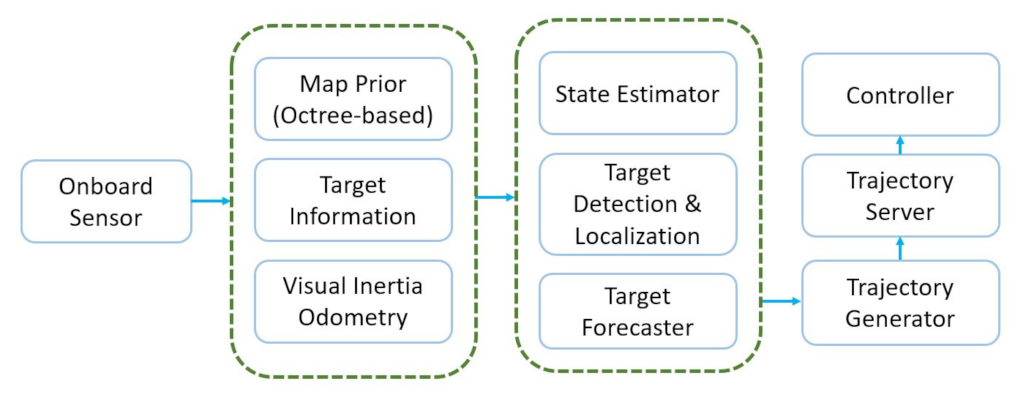
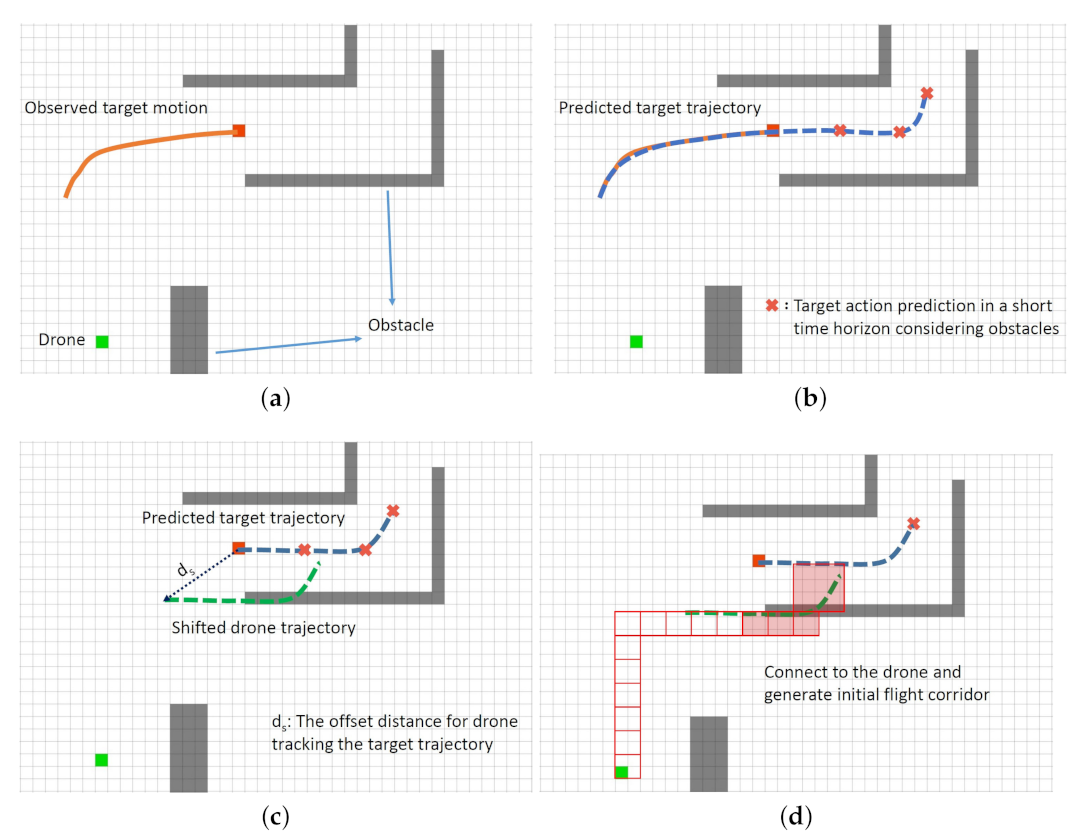
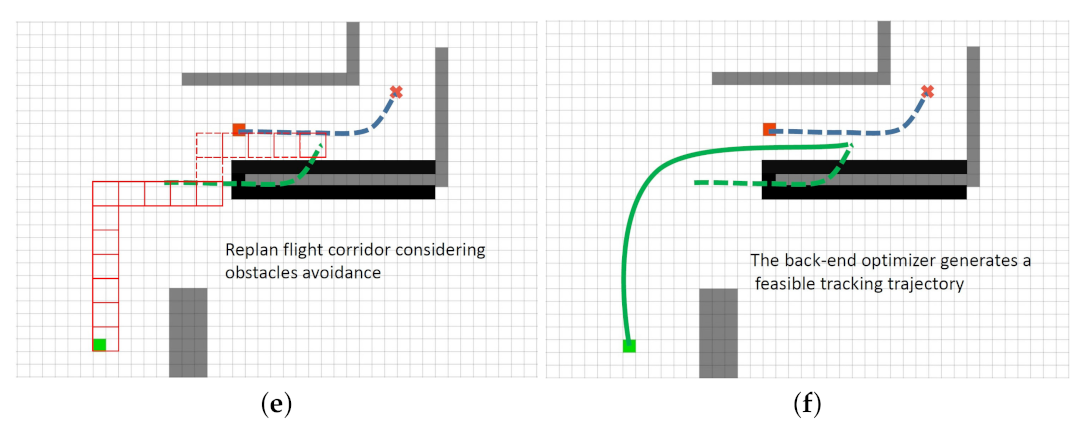
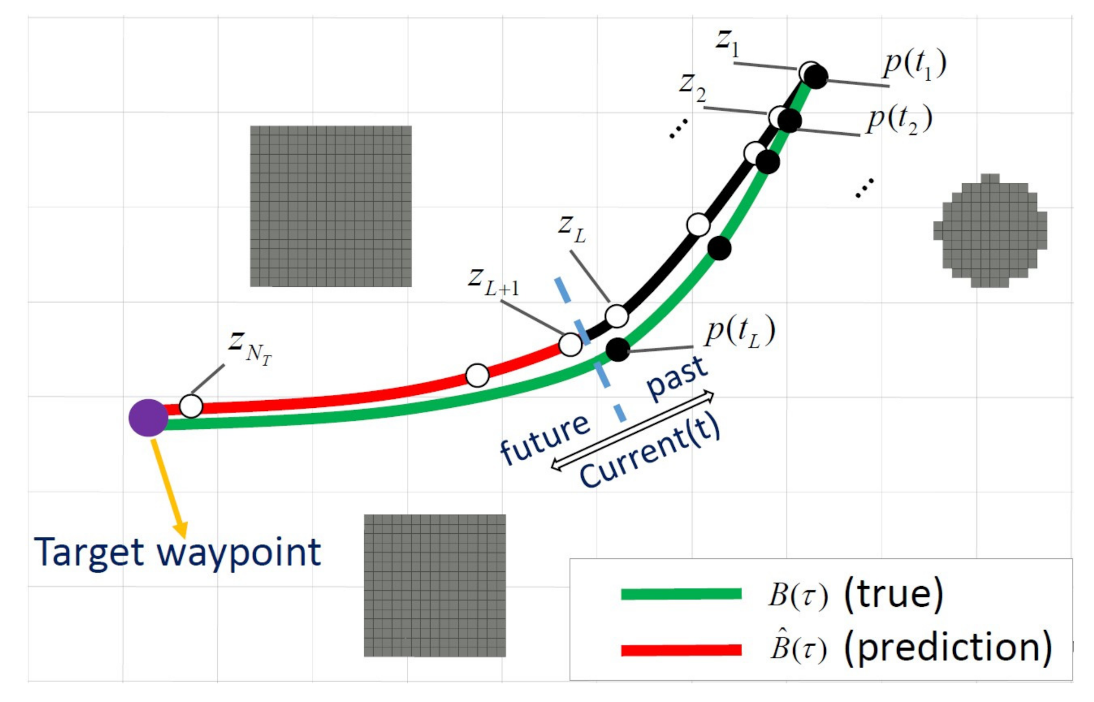
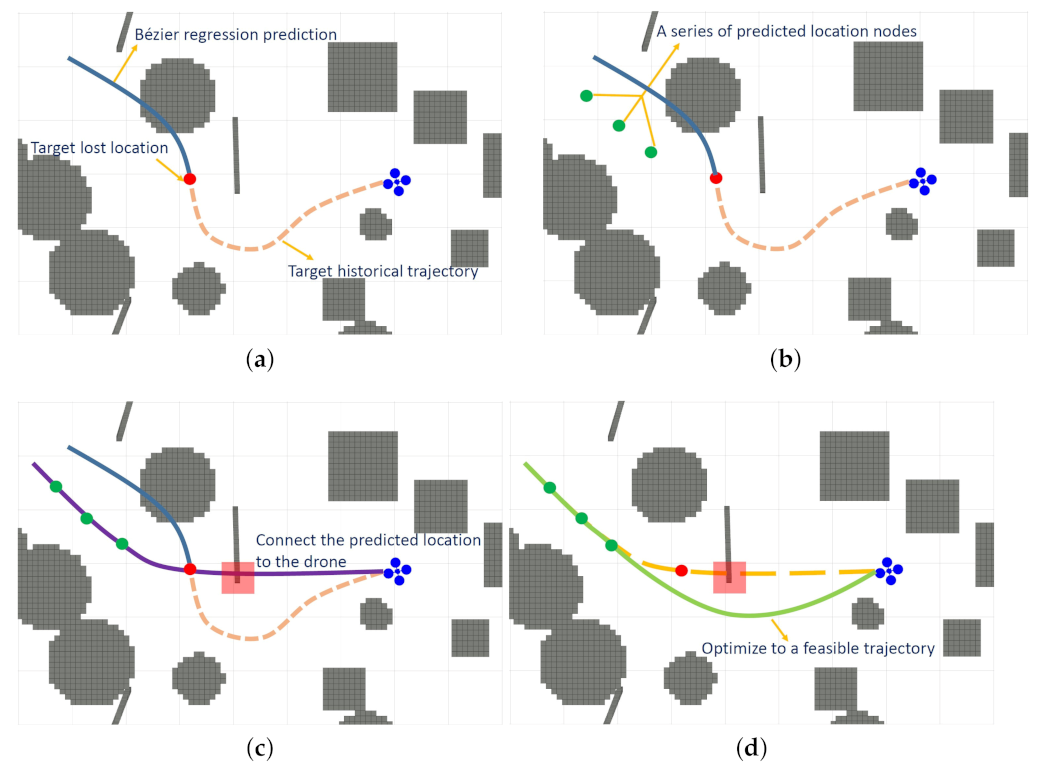

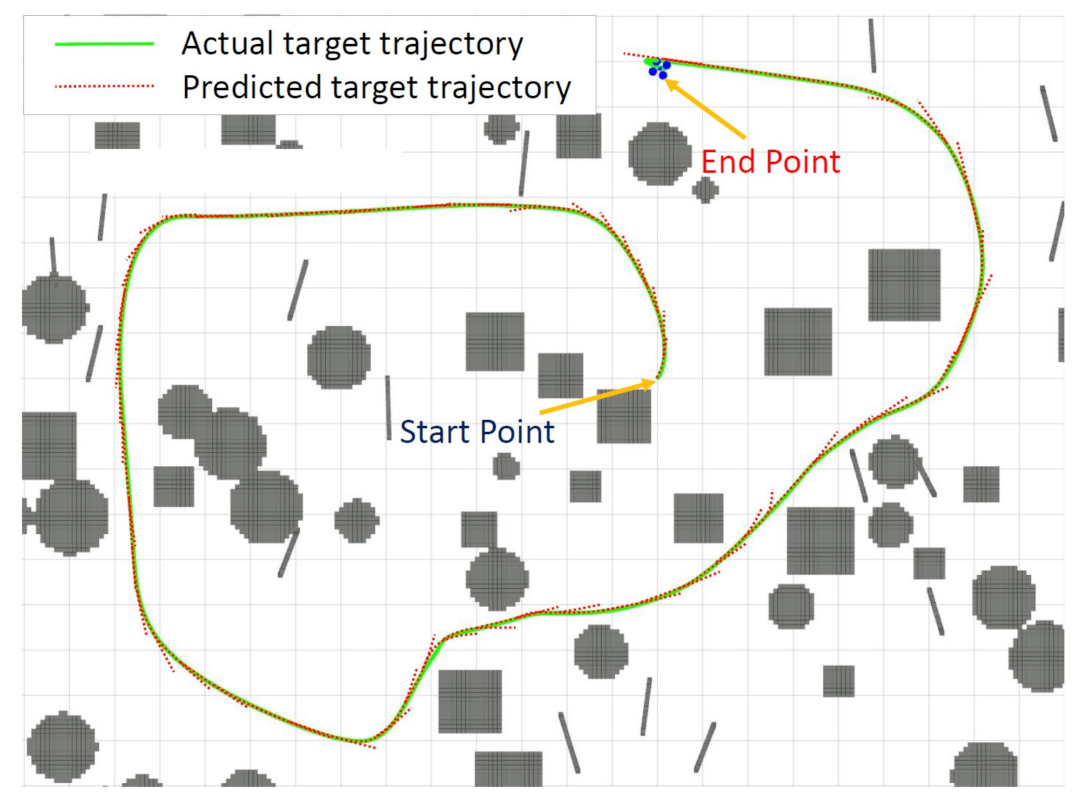
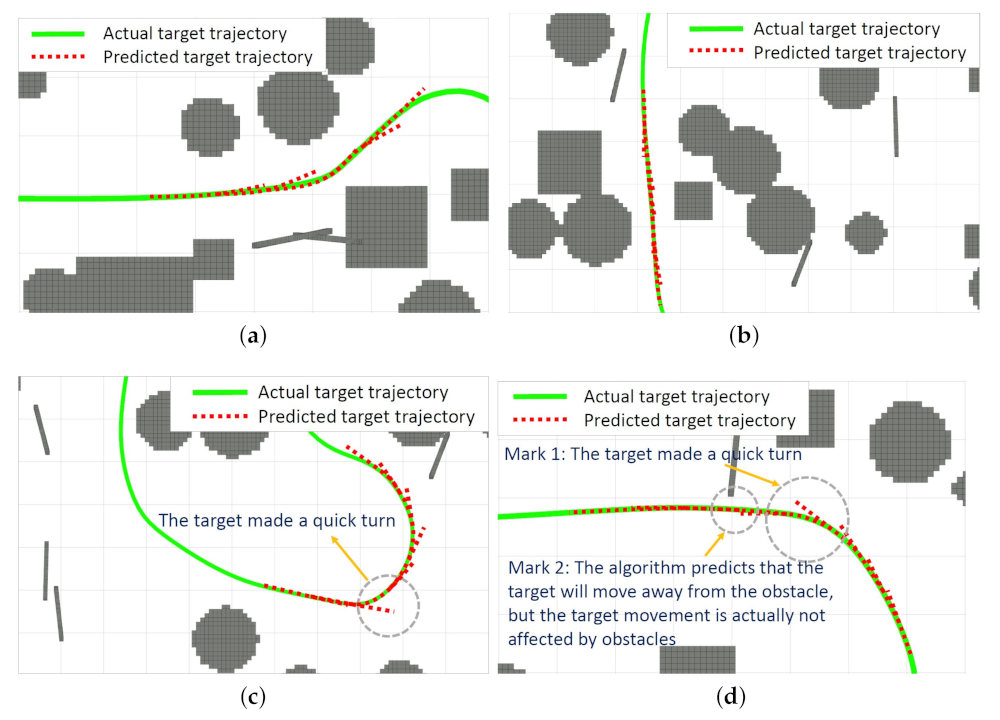

Publisher’s Note: MDPI stays neutral with regard to jurisdictional claims in published maps and institutional affiliations. |
© 2022 by the authors. Licensee MDPI, Basel, Switzerland. This article is an open access article distributed under the terms and conditions of the Creative Commons Attribution (CC BY) license (https://creativecommons.org/licenses/by/4.0/).
Share and Cite
Cui, S.; Chen, Y.; Li, X. A Robust and Efficient UAV Path Planning Approach for Tracking Agile Targets in Complex Environments. Machines 2022, 10, 931. https://doi.org/10.3390/machines10100931
Cui S, Chen Y, Li X. A Robust and Efficient UAV Path Planning Approach for Tracking Agile Targets in Complex Environments. Machines. 2022; 10(10):931. https://doi.org/10.3390/machines10100931
Chicago/Turabian StyleCui, Shunfeng, Yiyang Chen, and Xinlin Li. 2022. "A Robust and Efficient UAV Path Planning Approach for Tracking Agile Targets in Complex Environments" Machines 10, no. 10: 931. https://doi.org/10.3390/machines10100931
APA StyleCui, S., Chen, Y., & Li, X. (2022). A Robust and Efficient UAV Path Planning Approach for Tracking Agile Targets in Complex Environments. Machines, 10(10), 931. https://doi.org/10.3390/machines10100931







